The 2013 MacBook Air: Core i5-4250U vs. Core i7-4650U
by Anand Lal Shimpi on July 4, 2013 8:00 AM ESTBoot Performance
Although boot performance doesn't change substantially with the faster CPU, I did notice that the new system was posting better boot times than what I had previously recorded. My guess is all of my SSD torturing hadn't been TRIMed away before I presented the previous results. Either way the new MBA seems capable of a sub-12 second boot time. I even recorded some boots as low as 10.8 seconds. That PCIe SSD comes in handy for sure.
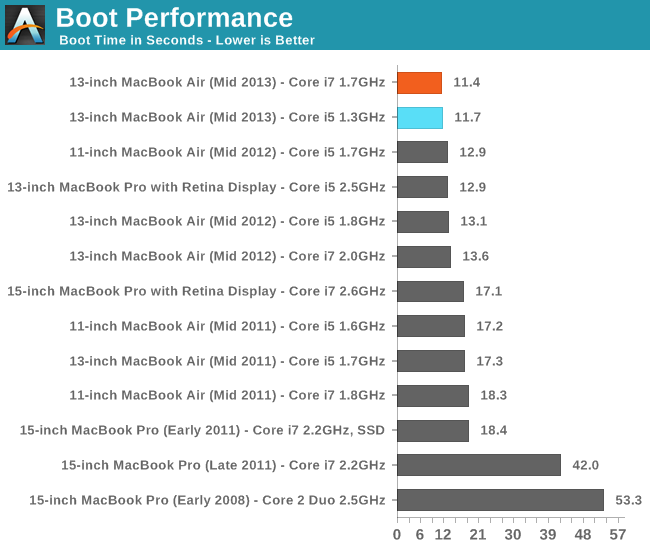
Single Threaded FP & 3D Rendering Performance
These next two charts look at single and multithreaded floating point performance using Cinebench 11.5. This test also gives us the rare opportunity of comparing to some older Mac Pro hardware as well from 2008 - 2010. Single threaded performance remains extremely important to overall system responsiveness, so it's always good to look at.
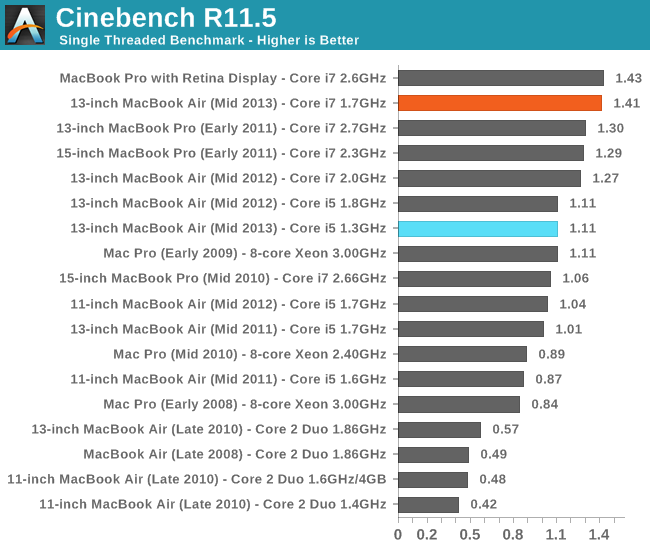
Oh man, the Core i7 upgraded seriously fixes everything. We get near perfect scaling here, showing a massive 27% increase in performance over the default Core i5 1.3GHz setup. The single threaded performance of the upgraded 13-inch MacBook Air is almost able to equal that of the 15-inch MacBook Pro with Retina Display. Anyone underwhelmed by Haswell should keep this in mind. What we're seeing here is a combination of IPC improvements and awesomely aggressive turbo, all within a 15W TDP.
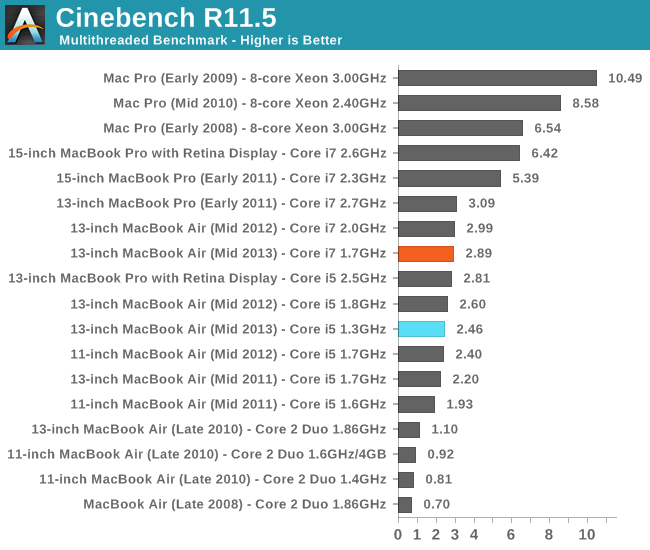
The multithreaded story is a bit less impressive, but still quite good. Showing a 17% increase in performance, the 1.7GHz Core i7 delivers nearly the same performance as the 2GHz Core i7 upgrade from last year's MBA. The rMBP15 distances itself from the MacBook Air though - there's no replacement for more cores.
Video Transcoding Performance
Video transcoding is really best suited for the higher end machines, but that doesn't change the fact that it's done on MacBook Airs as well. We'll start by looking at performance under iMovie. Here we're importing 1080p video from a Nikon D7000 and optimizing it during import.
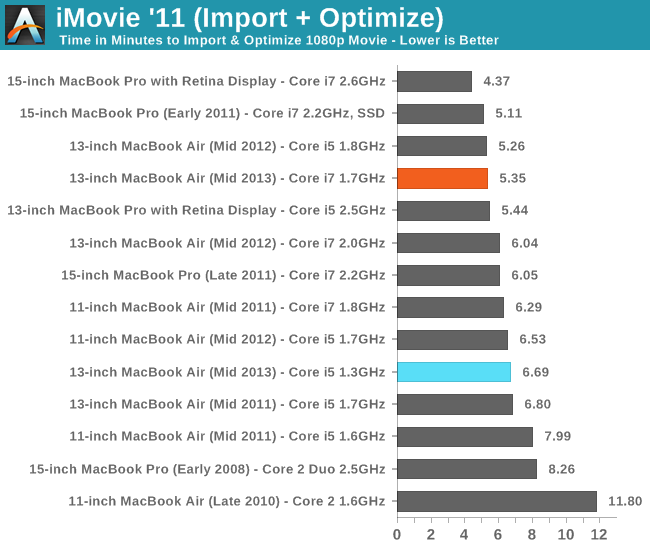
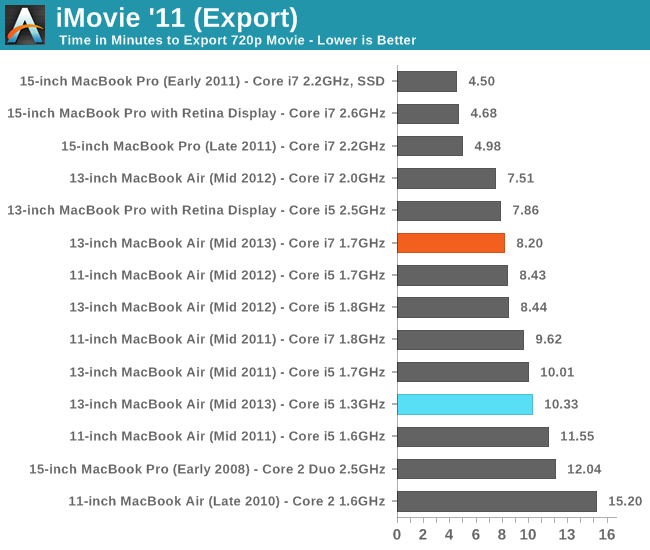
We're showing ~25% reductions in import and export time here over the base configuration. In both cases, performance equivalency with last year's upgraded configuration seems restored.
Final Cut Pro X falls on the professional end of the video production spectrum. The test file is the same here, but the workload is far more strenuous.

The same is true for our FCPX test. Last year's 2.0GHz model is about 5% quicker than this year's 1.7GHz Haswell ULT system, but obviously with the newer machine you get much better battery life. The improvement over the base CPU configuration is over 20% again.
Photo Editing & Export Performance
Our photo editing & export tests agree with what we've seen elsewhere. The gains here are north of 20% and put the i7 system within range of last year's 2GHz model.


Xcode Performance
In our desktop review of Haswell I noted that performance in our compile test improved tremendously with the new architecture. As it's quite obvious that Haswell's IPC advantages don't surface all that much in our traditional suite, I wanted to see if perhaps things would be different in something that might lend itself better to Haswell's IPC improvements. I repeated our Firefox build test but under OS X. It's a multithreaded compile, with the number of threads set to 2x the number of cores (not threads) in a system.
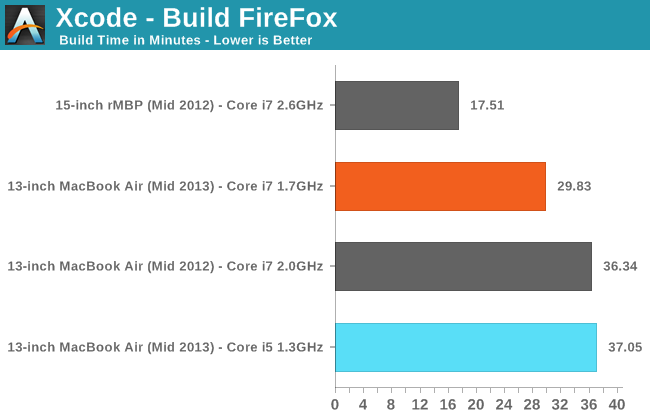
When Haswell's IPC advantage can shine, the higher clocked configuration does even more so. Here the 1.7GHz Core i7-4650U is over 20% faster than the fastest MacBook Air you could build last year. Serious developers will still want more cores but if you need ultimate portability, Haswell ULT really can shine.










127 Comments
View All Comments
FwFred - Thursday, July 4, 2013 - link
Probably the benefits matter much more in non-optimal cases. I think Anand's experience mirrors my own. One bad browser tab can kill the battery life due to javascript or flash. If Mavericks is able to prevent this somehow (not really sure how it could do it within Chrome between tabs, but maybe Safari), I would be very pleased.solmaker - Thursday, July 4, 2013 - link
Thanks for the sage observations, K-Knight. If you're right that Mavericks moves heavier workloads down toward the "light" category, that would tend to decrease the i5 vs i7 battery difference, since they're very close when "light". But I'd think even the "light" case would be helped by Timer Coalescing (batching periodic timer wake-ups) and AppNap (by nailing unused background tasks). My fantasizing about 12 hour MBA 11" battery life was based on anecdotal forum reports of 13+ hour 11" life using the Mavericks beta, but that hasn't been verified. My own usage often has an idle VMware Fusion WinXP session in the background, so I'd get great benefits if AppNap could zap that.KitsuneKnight - Friday, July 5, 2013 - link
Thinking about it more, the light load would also receive some benefit as well. Before when I wrote 'light', I was more so thinking about a system with no apps running, effectively just sitting idle... which is obviously not a 'light' workload, but a no-workload. Although with the current low energy usage of OS X the gains might not be massive (maybe even within the margin of error).I still think the best cases will be with poorly programmed apps with lots of useless timers keeping the system awake, which Timer Coalescing will help a bit with when the app is in the foreground, and AppNap much more so when it's in the background.
I'm not sure how Fusion is architectured, but I /think/ how it works (based on how Workstation was many years ago... on Windows) it won't automagically be able to benefit from AppNap, and VMware will have to put a bit of effort into making it opt into AppNap when appropriate. Parallels Desktop already has a feature where (under the right circumstances), idle VMs will be paused, although it's not as aggressive as it could be.
It'll be interesting to see how developers make their apps work with AppNap (most won't have to do anything beyond linking against the 10.9 frameworks). I imagine at the start many developers will just try to disable AppNap for their app and write blog posts about how 'it's so pointless and doesn't everyone just leave their computer plugged in', before everyone starts embracing it... but maybe I'm jaded from how new technologies get adopted in Windows / Linux land.
solmaker - Saturday, July 6, 2013 - link
Thanks again, K-K. I wonder whether AppNap with be "Opt In" or "Opt Out"? If the latter, then VMware Fusion may automagically AppNap when hidden.fokka - Thursday, July 4, 2013 - link
thanks for the comparison, anand! these are exactly the questions i'm wondering about when researching for a mobile pc: is there a benefit in battery life when chosing a low end cpu, or is the faster cpu just quicker and can even save power with longer idling times?for me it would be clear to chose the i7 here, since it would be be my main computer and battery is similar to the i5 in scenarios most likely with my usage: light workload. but then, if i decide to load up lightroom or want to play a quick game, i can rest assured that i'm eeking out quite a couple percent more performance than on the stock cpu.
now the only thing i'm waiting for is a proper zenbook-refresh :)
ananduser - Thursday, July 4, 2013 - link
I feel you Anand; too bad that other companies don't offer such "one size fits all" lineups like Apple. The exaggerate range of choices from other companies simply adds confusion.I like the detail and effort that went into reviewing different SKUs of the same unit. Hope you do the same for some upcoming items from Lenovo, Asus, Samsung, Sony etc.
Since I mentioned Sony, I want to ask you if there is a chance you could get your hands on the new Vaio Pro and Vaio Duo that sport that "fancy" triluminous display. None of the reviews available has actually gone the length to see what's with that new "quantum dot" tech. Only Anandtech™ can shed light here. What ? Sony hardly sends you Vaios for review ? I dunno, ask them harder ?
Awful - Thursday, July 4, 2013 - link
Thanks Anand, very useful!Any chance of including some GPU/Gaming comparisons too? It would be interesting to see the results of the increased thermal constraints of the i7 on GPU perf (could even be worse I imagine under certain loads?)
ciparis - Thursday, July 4, 2013 - link
If Firefox really takes 17-37 minutes to build, all I can say is wow, what a %$#@! pig.Mackan - Friday, July 5, 2013 - link
Can you also do a battery life test in Windows, via Boot Camp, using pure EFI install which seems to be supported now.US Fiscal Situation - Friday, July 5, 2013 - link
Yeah.. no one else can make thinner and lighter laptops, erm... except for the firms that can and do...Take the Vaio Pro 11, it weighs less (870g), it's thinner and yet has the same battery life.
The Vaio manages to cram in a much higher resolution (full HD) TOUCHSCREEN, NFC and SD card reader. It even has Ethernet support built into the power supply which creates a WIFI hotspot
Both machines are comparable performance/processor wise but one costs £60 less (i7,4GB RAM, 256GB SSD)- No prizes for guessing which.
BTW apropos business use- it should be noted that the lack of boot camp drivers for W8 means that you can't run all of the programs that you might need.
US Fiscal Situation http://bit.ly/16SsEFt